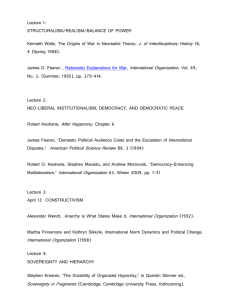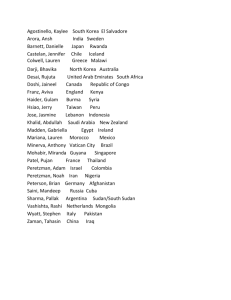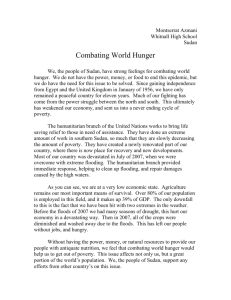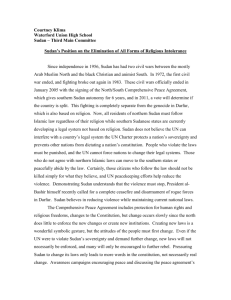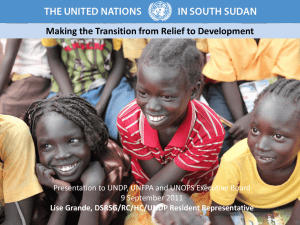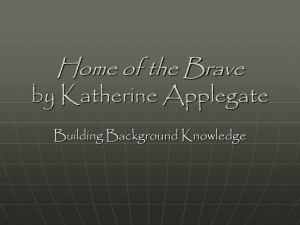One challenge or two? - SOAS University of London
advertisement
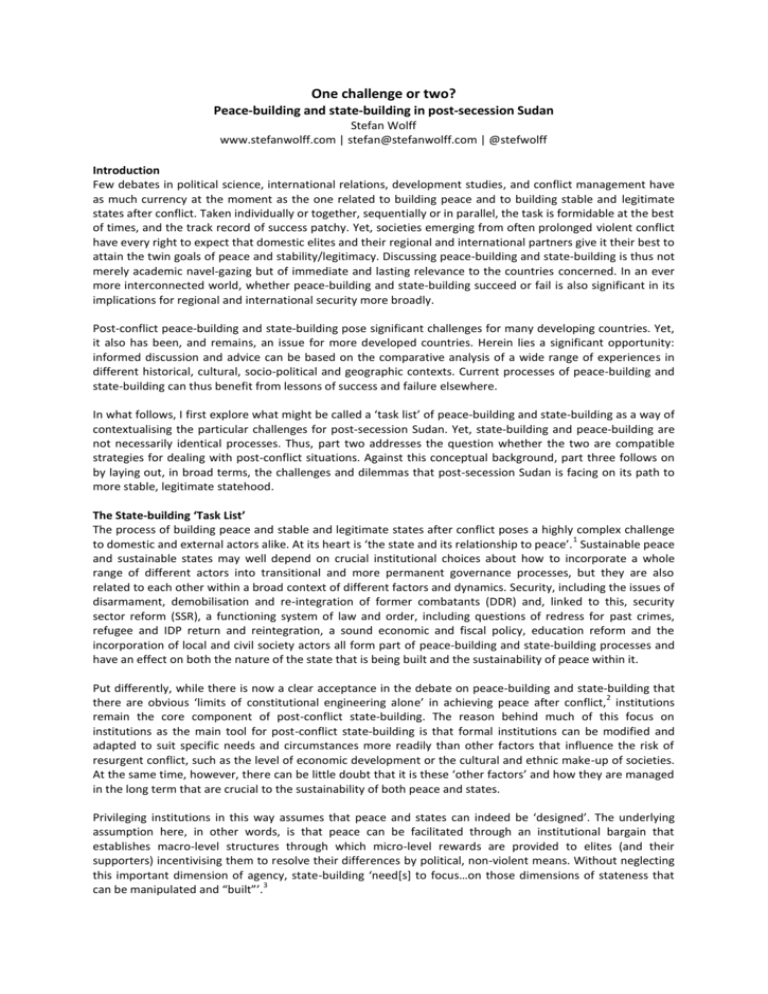
One challenge or two? Peace-building and state-building in post-secession Sudan Stefan Wolff www.stefanwolff.com | stefan@stefanwolff.com | @stefwolff Introduction Few debates in political science, international relations, development studies, and conflict management have as much currency at the moment as the one related to building peace and to building stable and legitimate states after conflict. Taken individually or together, sequentially or in parallel, the task is formidable at the best of times, and the track record of success patchy. Yet, societies emerging from often prolonged violent conflict have every right to expect that domestic elites and their regional and international partners give it their best to attain the twin goals of peace and stability/legitimacy. Discussing peace-building and state-building is thus not merely academic navel-gazing but of immediate and lasting relevance to the countries concerned. In an ever more interconnected world, whether peace-building and state-building succeed or fail is also significant in its implications for regional and international security more broadly. Post-conflict peace-building and state-building pose significant challenges for many developing countries. Yet, it also has been, and remains, an issue for more developed countries. Herein lies a significant opportunity: informed discussion and advice can be based on the comparative analysis of a wide range of experiences in different historical, cultural, socio-political and geographic contexts. Current processes of peace-building and state-building can thus benefit from lessons of success and failure elsewhere. In what follows, I first explore what might be called a ‘task list’ of peace-building and state-building as a way of contextualising the particular challenges for post-secession Sudan. Yet, state-building and peace-building are not necessarily identical processes. Thus, part two addresses the question whether the two are compatible strategies for dealing with post-conflict situations. Against this conceptual background, part three follows on by laying out, in broad terms, the challenges and dilemmas that post-secession Sudan is facing on its path to more stable, legitimate statehood. The State-building ‘Task List’ The process of building peace and stable and legitimate states after conflict poses a highly complex challenge 1 to domestic and external actors alike. At its heart is ‘the state and its relationship to peace’. Sustainable peace and sustainable states may well depend on crucial institutional choices about how to incorporate a whole range of different actors into transitional and more permanent governance processes, but they are also related to each other within a broad context of different factors and dynamics. Security, including the issues of disarmament, demobilisation and re-integration of former combatants (DDR) and, linked to this, security sector reform (SSR), a functioning system of law and order, including questions of redress for past crimes, refugee and IDP return and reintegration, a sound economic and fiscal policy, education reform and the incorporation of local and civil society actors all form part of peace-building and state-building processes and have an effect on both the nature of the state that is being built and the sustainability of peace within it. Put differently, while there is now a clear acceptance in the debate on peace-building and state-building that 2 there are obvious ‘limits of constitutional engineering alone’ in achieving peace after conflict, institutions remain the core component of post-conflict state-building. The reason behind much of this focus on institutions as the main tool for post-conflict state-building is that formal institutions can be modified and adapted to suit specific needs and circumstances more readily than other factors that influence the risk of resurgent conflict, such as the level of economic development or the cultural and ethnic make-up of societies. At the same time, however, there can be little doubt that it is these ‘other factors’ and how they are managed in the long term that are crucial to the sustainability of both peace and states. Privileging institutions in this way assumes that peace and states can indeed be ‘designed’. The underlying assumption here, in other words, is that peace can be facilitated through an institutional bargain that establishes macro-level structures through which micro-level rewards are provided to elites (and their supporters) incentivising them to resolve their differences by political, non-violent means. Without neglecting this important dimension of agency, state-building ‘need[s] to focus…on those dimensions of stateness that 3 can be manipulated and “built”’. Stefan Wolff Peace-building and state-building in post-secession Sudan 2 State-building vs. Peace-building 4 There are no universally agreed definitions of either state-building or peace-building, nor is there agreement 5 on the compatibility of peace-building and state-building. However, there is a tangible trend to view them as compatible in post-conflict environments. Some conceptual clarification is, therefore, in order to establish the extent to which state-building and peace-building converge and diverge. In many ways, the perhaps best way of looking at this is by considering the sequence and/or timing of specific tasks on the peace/state-building list. Before any building of state institutions can commence with a reasonable expectation of success, minimum levels of security need to be achieved internally and externally. The state-building literature, albeit predominantly focused on internal peace (-building), recognises the importance of security, and concomitant tasks such as DDR and SSR, for achieving stability and legitimacy, but equally accepts that a narrow focus on security will not suffice in achieving these outcomes. In terms of sequencing, ‘security first’ is by now an accepted paradigm of state-building, but there is equally an acceptance that ‘security only’ cannot succeed in achieving the twin outcomes of peace and stability/legitimacy after conflict. Building effective institutions of governance, implementing policies for economic development, and fostering the participation of all relevant actors in society in the state-building effort are part and parcel of the combined peace- and state-building task list which cannot be ignored if the process is to succeed and create sustainable peace in a stable and legitimate state. Security is not only a crucial pre-condition for the success of state-building but it is also linked to it through the notion of legitimacy. Security is more than just a state of affairs which individuals perceive, but it implies a 6 political claim of legitimacy, that is, ‘the transformation of coercion into security through the rule of law.’ Security and political legitimacy are thus very closely connected: a post-conflict state’s capacity to provide security will crucially determine its legitimacy, and vice versa the political legitimacy it has (in terms of elections, representation and participation of key stakeholders) conditions the degree to which security is seen by citizens as protecting them or as merely the continuation of conflict by other means. State-builders need to consider carefully their options in this context—between confronting local power-brokers, who may have provided a semblance of security in areas under their control during conflict, and integrating them in the statebuilding effort. While the latter strategy of ‘integrating vigilantes and exclusionary sub-state groups into postconflict orders ... poses considerable problems’, such compromises have a historical record of aiding the 7 ‘legitimacy of the new democratic order’. In other words, the design of institutions, including of the rules of representation and participation, can contribute to achieving a sustainable, secure environment for statebuilding, economic development, etc. Institution building, thus, also provides the link between security based on coercive capacity (of domestic and/or external actors) and security that derives from rule of law. This is another factor that underlines the significance of a focus on the institution-building process and the importance of ‘choosing’ a set of institutions that can effectively provide this link. While peace-building and state-building are thus not identical processes, they are closely connected. Specific tasks frequently overlap, and unsurprisingly so: peace is more likely and sustainable if states function well and serve their citizens; and states, in turn, are more likely to provide the public goods their citizens rightly expect of them if they operate under conditions of peace. In other words, by establishing and/or strengthening state institutions in the post-conflict environment of divided societies, a tangible and positive contribution can be made to sustainable peace. While normatively appealing, and perhaps even logically convincing, this view encounters two empirical problems. The first is that processes of state-building (or state formation) are historically long, and 8 predominantly violent processes, encapsulated famously in Charles Tilly’s formulation that ‘war makes states’ and are consequently at odds with the immediate requirements of achieving peace (or at least an end to hostilities). The other potential problem arises when state-building is tied to the specific outcome of a 9 democratic state. Even that incompatibility is not a principal one—democracy is clearly possible after violent conflict. However, it is also empirically correct that processes of democratisation (i.e., the process of building democratic states), especially in ethnically, linguistically, religiously, ideologically or otherwise diverse, and 10 potentially divided, societies, are environments prone to conflict escalation. Similarly, democracy in such 11 societies requires a range of special institutional safeguards to prevent the emergence of conditions in which divisions within society (for example between different ethnic, religious, or socio-economic status groups) gain a salient discriminatory dimension and eventually facilitate the rise of violence as a means to realise group interests. Put differently, institutional choices at the very beginning of a post-conflict peace/state-building Stefan Wolff Peace-building and state-building in post-secession Sudan 3 process provide the link between the two. Choosing institutions, from this perspective, means to agree on governance arrangements in which peace and security can be sustained while the broader process of statebuilding takes place in the course of which a full range of legitimate institutions can be established. Sudan’s Challenges The aim of this short essay is to set the conceptual context for a debate on “Challenges and Prospects of StateBuilding in Post-Secession Sudan”, not to pre-empt it. Yet, this particular conceptual discussion can benefit from an empirical illustration of what I consider Sudan’s most pressing challenges at the end of 2011, a year that has seen Africa’s once largest country accept the secession of what is now the independent Republic of South Sudan. Post-secession Sudan is a state, it has established institutions with a track record of providing services and governance. Without a doubt, many questions can be raised about how effective, stable, and legitimate these all are, but Sudan is neither a failed nor a new state. So state-building in Sudan cannot, and need not, proceed from a tabula rasa, but its point of departure are the current institutions and political and economic structures and processes in place. In this sense, state-building in Sudan is about reform, and arguably improvement, of existing institutions, structures, and processes, not about creating them. It would be wrong, however, to mistake this for a lesser challenge than building a state from scratch. Existing institutions in Sudan are not universally legitimate: in order to become more widely acceptable to all citizens, Sudan will need to embark on a course of truly inclusive institutional and constitutional reform. The current government has a clear responsibility here in making such a process possible, but it is equally incumbent on its opponents to participate in it. When it comes to peace-building, the situation is partially, but significantly different. Building peace in and around Sudan is neither a simple nor a singular challenge. Sudan needs sustainable peace with itself in Darfur, the east, and now also/again the south (South Kordofan and Blue Nile states). These internal regional conflicts are inextricably linked with broader regional dynamics: sustainable peace in Sudan is impossible without stable and peaceful relations with its neighbours: Eritrea and Ethiopia in the East, Chad and CAR in the west. Above all, peace within Sudan and the region requires avoiding full-scale military hostilities with South Sudan, and the key here is obviously resolving the Abyei dispute. In all of these dimensions, there are some recent gains to build on (such as improved relations with Chad and Ethiopia and the, albeit piecemeal, peace accords with various insurgent groups) in the East and Darfur. 12 Another challenge is related to the country’s economic development. Secession of the South meant a loss of about two-thirds of annual oil production and the revenues associated with it. Even if a sustainable revenuesharing model is finally established with South Sudan (which so far lacks its own refineries and has no other export route than through Sudan), overall government revenue in Sudan is likely to decrease by between 20% and 30% until alternative sources of income are found. But in light of continuing security problems, Western divestment and insufficient FDI from other sources, achieving the necessary economic diversification is at best going to be a difficult and slow process. This is compounded, among others, by US-led trade sanctions, high inflation, high external debt, and decreasing foreign currency reserves. At a time of global economic and financial crisis and a major food crisis and famine, especially in East Africa, Sudan’s economic difficulties, compounded by its political and security problems, may well spark a humanitarian crisis for which neither the country itself nor its international and regional partners are particularly well prepared. A final challenge relates to Sudan’s international isolation. In addition to the trade sanctions already mentioned, Sudan is currently affected by an arms embargo, and a travel ban and assets freeze against specifically designated individuals under the terms of UN Security Council Resolution 1591(2005). Furthermore, the International Criminal Court has indicted the current president of Sudan, Omar Hassan Ahmad al-Bashir, the former interior and current humanitarian affairs minister, Ahmad Muhammad Harun, 13 and the alleged leader of the Janjaweed militias, Ali Muhammad Ali Abd-Al-Rahman. Given the widely acknowledged significance of international support for the success of peace-building and state-building 14 processes, the isolation of Sudan from potential major Western partners cannot but be detrimental to the prospects of success for these processes. Stefan Wolff Peace-building and state-building in post-secession Sudan 4 Conclusion A recent study on state-building and democratization in sub-Saharan Africa, found that rule of law—conceived of as popular perceptions of improvements in personal security and leaders’ respect of the constitution—is the 15 most critical factor to success in building democratic states. While the crucial role of security in legitimising institutions has already been noted above, it is worthwhile pointing to the emphasis put on leaders’ respect of the constitution. Apart from the critical role of leadership, there are two other factors that are essential to the successful management of the demands of the near-simultaneous processes of peace-building and state-building: diplomacy and institutional design. Getting the institutions right that are to make peace possible and states sustainable cannot be underestimated in its importance. Given the complexity of such a challenge, international support is equally crucial. The considerable experience that has been accumulated in the international community over the decades is one element which diplomacy can contribute by helping local leaders enhance their capacity to master the task of peace-building and state-building. Similarly important is the political and financial, and sometimes military support that is required in what is a long process rather than singular event of peace-building and state-building. Having said that, no degree of ingenuity in institutional design and no amount of international support can, or indeed should attempt to, make up for a lack of leadership. Where skill, vision and determination are missing, whatever peace and whatever state are built cannot be expected to be sustainable. This general lesson holds true for Sudan as well: it is up to Sudan’s leaders, the people they serve, and their regional and international partners to ensure that post-secession Sudan can be a stable, prosperous, and legitimate state at peace with itself and its neighbours. Stefan Wolff Peace-building and state-building in post-secession Sudan 5 Notes 1 Charles T. Call, 'Ending Wars, Building States', in Charles T. Call and Vanessa Wyeth (eds.) Building States to Build Peace (Boulder, CO: Lynne Rienner Publishers 2008), p. 3.. 2 Pippa Norris, Driving Democracy: Do Power-sharing Institutions Work? (Cambridge: Cambridge University Press 2008) p. 220. See also Rolf Schwarz, 'Post-Conflict Peacebuilding: The Challenges of Security, Welfare and Representation', Security Dialogue, 36/4 (2005) pp. 429-46.. 3 Francis Fukuyama, State-building: governance and world order in the twenty-first century (London: Profile Books 2004) p. 57.. For a contrary view arguing against a focus on institution building, see Kora Andrieu, 'Civilizing Peacebuilding: Transitional Justice, Civil Society and the Liberal Paradigm', Security Dialogue, 41/5 (2010) pp. 537-58.. 4 A third term used in this context is ‘nation-building’: see Fukuyama, p. 50., James F. Dobbins, 'America's role in nationbuilding: from Germany to Iraq', Survival, 45/4 (2003) pp. 87-110.; Michael Ignatieff, Empire lite: nation building in Bosnia, Kosovo, Afghanistan (Toronto: Penguin 2003).; and Juan J. Linz, 'State building and nation building', European Review, 1/4 (1993) pp. 355-69.. 5 See Edward Newman, 'Liberal Peacebuilding Debates', in Edward Newman, Roland Paris and Oliver P. Richmond (eds.) New Perspectives on Liberal Peacebuilding (Tokyo: United Nations University Press 2009).. 6 Barnett R. Rubin, 'The Politics of Security in Postconflict Statebuilding', in Charles T. Call and Vanessa Wyeth (eds.) Building States to Build Peace (Boulder, CO: Lynne Rienner 2008), p. 30.. 7 William Reno, 'Bottom-Up Statebuilding?', in Charles T. Call and Vanessa Wyeth (eds.) Building States to Build Peace (Boulder, CO: Lynne Rienner 2008), pp. 35-7.. 8 Charles Tilly, 'War Making and State Making as Organised Crime', in Peter B. Evans, Dietrich Rueschemeyer and Theda Skocpol (eds.) Bringing the State Back In (Cambridge: Cambridge University Press 1985), p. 170. Also Cameron G. Thies, 'Public Violence and State Building in Central America', Comparative Political Studies, 39/10 (2006) pp. 1263-82.. 9 This is also normatively problematic, not least because it is often tied to (or confused with) a Western-dominated ‘democracy-promotion’ agenda. While I am personally a strong supporter of the idea of building democratic states in the sense that institutions are in place that guarantee and protect a range of basic human and minority rights and give individual citizens opportunities to participate in the governance of their countries, I accept that this may not always be possible or preferred by the people concerned. Hence, I generally use the phrase ‘stable and legitimate state’ to describe the desired outcome of peace- and state-building processes. 10 Cf., for example, Jack Snyder, From Voting to Violence: Democratization and Nationalist Conflict (New York: Norton 2000).. 11 A recent discussion of the wide range of such mechanisms and how to establish them is Stefan Wolff and Christalla Yakinthou (eds.) Conflict Management in Divided Societies: Theories and Practice (London: Routledge 2011).. See also Sujit Choudhry (ed.) Constitutional Design for Divided Societies: Integration or Accommodation (Oxford: Oxford University Press 2008).. 12 For a general assessment of Sudan’s economy, see International Monetary Fund, Sudan: Second Review Under the 2009– 10 Staff-Monitored Program, (Washington, D.C.: International Monetary Fund 2011). For the particular post-secession challenges, see Masood Ahmed, Sudan and South Sudan: New Era, New Opportunities, (2011). 13 While Bashir, Harun, and Abd-Al-Rahman remain at large, three further indictees, the Chairman and General Coordinator of Military Operations of the United Resistance Front, Bahar Idriss Abu Garda, the Commander-in-Chief of Justice and Equality Movement, Abdallah Banda Abakaer Nourain, and the former Chief of Staff of SLA-Unity, Saleh Mohammed Jerbo Jamus, are currently standing trial. 14 Timothy D. Sisk, for example, has noted that ‘extended commitments [by the international community] to war-torn societies need to be the norm, not the exception’ if ‘bringing about lasting peace through democratization in societies shattered by war’ is to succeed. Timothy D. Sisk, 'Peacebuilding as democratization: findings and recommendations', in Anna K. Jarstad and Timothy D. Sisk (eds.) From War to Democracy: Dilemmas of Peacebuilding (Cambridge: Cambridge University Press 2008), pp. 256-7.. 15 Michael Bratton and Eric C. C. Chang, 'State Building and Democratization in Sub-Saharan Africa', Comparative Political Studies, 39/9 (2006) pp. 1059-83..
